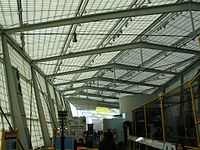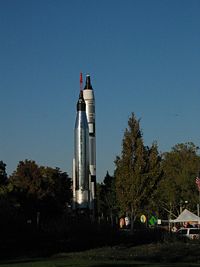- New York Hall of Science
-
Coordinates: 40°44′50″N 73°51′06″W / 40.7472°N 73.8517°W
New York Hall of Science Established 1964 Location Flushing Meadows–Corona Park, Queens USA Website New York Hall of Science
The New York Hall of Science occupies one of the few remaining structures of the 1964 New York World's Fair in Flushing Meadow-Corona Park in the borough of Queens in New York City. Today, it stands as New York City's only hands-on science and technology center. The more than 400 hands-on exhibits explore biology, chemistry, and physics.Contents
History
The museum was established in 1964 as part of the World's Fair in Flushing Meadows-Corona Park[1][2] and at the time was one of only a few science museums in existence.[3] Unlike many other institutions, which were closed immediately or soon after the Fair,[4] the Hall remained open after the fair, and served as a resource for students.[5] Its exhibits at the time were somewhat limited but included plans for the world's first atomarium open to the public.[6] The Hall remained open until 1979, when it closed for major renovations.
New York City hired physicist Alan Friedman in 1984 to help with the museum's transition[3] and he oversaw the change from a focus on science fiction to relevance in the lives of everyday lives.[7] After it re-opened in 1986 giving New York City a science museum for the first time since it had closed seven years earlier,[8] plans for the display of an atom were realized with a $40,000 exhibit for a quantum atom that was a part of a $400,000 expansion and renovation at the museum.[9] The museum's growth and ability to draw crowds was unexpected and led to the city's pursuit of further funds and expansion.[10]
At the time of its re-opening, the museum was unique in that it also provided a training program for science majors who could then go on to study under a tuition waiver program at nearby Queens College[11] in exchange for committing to spend at least two years in city schools who needed science educators.[12] Its role in the life of city school children continued, and in 1991 it announced plans for a ten-year, $80 million renovation and expansion to be able to meet the needs of a growing visitorship.[1] Further expansion, which included a new entrance, dining area and a science playground began in 1996[3] and reflected the need for constant updates in science museums to keep their displays up to date and relevant. In recognition of its continued upgrading, the Hall was granted the status of a New York City cultural institution, given to a limited number of organizations.[13]
In 1999 the decision was made to continue to grow and expand the museum without benefit of an IMAX, since it was determined the market was already saturated. Instead, funds were spent on doubling its exhibition space and restoring its famous rockets, which were donated by the Space program for the Worlds Fair[7] and returned in 2003.[14] Also in 2003, the Hall announced "Tech City" its $300m proposal for a science center as one of the cultural institutions located at Ground Zero.[15] Although "Tech City" made the short list of fifteen finalists in February 2004,[16] during a process that was criticized for a lack of openness and transparency,[17] but was not ultimately chosen.[18] It continues to look for a satellite location in Manhattan while it thrives in Queens.
Funding
In 2005, it was among 406 New York City arts and social service institutions to receive part of a $20 million grant from the Carnegie Corporation, which was made possible through a donation by New York City mayor Michael Bloomberg.[19][20] The Hall has continued to receive funding from a number of sources essential to its operation and expansion.[21][22] This represented a welcome change for the museum from the 1990s during which severe cuts in funding threatened its ability to operate successfully.[23]
Exhibits
The Hall mainly focuses on education for children ages 1–17 and its audience consists primarily of city children for whom the exposure to science is something new.[12] The museum includes a large permanent collection[24] as well as a range of travelling exhibitions. Although somewhat more common now, the museum was among the first to have its young visitors assess its exhibits and it welcomed their feedback in preparation for the re-opening in 1986.[25] The Hall's permanent exhibitions include:
- Connections: The Nature of Networks
- Feedback
- Hidden Kingdoms: The World of Microbes[26]
- Mathematica: A World of Numbers... and Beyond
- Marvelous Molecules- The Secret of Life
- Preschool Place
- Seeing the Light
- Sound Sensations: The Inside Story of Audio
- The Sports Challenge
- Technology Gallery
- Amateur Radio Station
References
- ^ a b Michel Marriott (1991-10-30). "Science Centers Help Bring Schoolwork to Life". New York Times. http://query.nytimes.com/gst/fullpage.html?res=9D0CE6D8103CF933A05753C1A967958260&sec=&spon=&pagewanted=all. Retrieved 2008-04-06.
- ^ Walter Sullivan (1966-09-22). "Hopeful Future Museum; But City's Hall of Science Still Retains Aura Reminiscient of the World's Fair". The New York Times. http://select.nytimes.com/gst/abstract.html?res=F60C11F63A54157A93C0AB1782D85F428685F9. Retrieved 2008-04-06.
- ^ a b c "A Bigger Window on Science". The New York Times. 1996-05-25. http://query.nytimes.com/gst/fullpage.html?res=9405E3DF1139F936A15756C0A960958260. Retrieved 2008-04-06.
- ^ Jon Marcus (1999-06-13). "The Future was Then; NYC Dusts Off Relics of Its Word's Fairs". The Washington Post. http://www.highbeam.com/doc/1P2-589789.html. Retrieved 2008-04-06.
- ^ "Students Bone Up in Museum at Old Fair Site". New York Times. 1968-11-11. http://select.nytimes.com/gst/abstract.html?res=F60910F73E54157493C3A8178AD95F4C8685F9. Retrieved 2008-04-06.
- ^ Sandra Blakeslee (1969-01-07). "First Atomarium Planned Here: A Hot Reactor Open to Public". New York Times. http://select.nytimes.com/gst/abstract.html?res=F70814F83C5E147493C5A9178AD85F4D8685F9. Retrieved 2008-04-06.
- ^ a b c Marcia Biederman (1999-07-11). "New Yorkers & Co.; Making a Science Center Grow, Without Imax". The New York Times. http://query.nytimes.com/gst/fullpage.html?res=9B02E4D9153CF932A25754C0A96F958260. Retrieved 2008-04-06.
- ^ Malcolm W. Browne (1986-09-05). "City Again Boasts a Science Museum". New York Times. http://select.nytimes.com/gst/abstract.html?res=F50710F63D580C768CDDA00894DE484D81. Retrieved 2008-04-06.
- ^ Malcolm W. Browne (1988-04-12). "Museum to Display Working Model of Atom". New York Times. http://query.nytimes.com/gst/fullpage.html?res=940DEED9123FF931A25757C0A96E948260. Retrieved 2008-04-06.
- ^ Joseph P. Fried (1988-08-27). "New York City's Hall of Science Discovers a Success Formula". The New York Times. http://query.nytimes.com/gst/fullpage.html?res=940DE3DE1F3AF934A1575BC0A96E948260. Retrieved 2008-04-06.
- ^ William H. Honan (1988-10-26). "Culture Commissioner Looks Back in Humor at a Bumpy First Year". New York Times. http://query.nytimes.com/gst/fullpage.html?res=940DE1DC143CF935A15753C1A96E948260&sec=&spon=&pagewanted=print. Retrieved 2008-04-06.
- ^ a b Malcolm W. Browne (1997-03-18). "Museum Innovator Delights in Bringing Science to the Public". New York Times. http://query.nytimes.com/gst/fullpage.html?res=990CEEDC1238F93BA25750C0A961958260&sec=&spon=&pagewanted=all. Retrieved 2008-04-06.
- ^ Pam Belluck (1996-05-21). "A New Star in Constellation of Art's Giants; Queens Landmark Wins a Coveted Cultural Title". The New York Times. http://query.nytimes.com/gst/fullpage.html?res=9504EFDC1039F932A15756C0A960958260&sec=&spon=&pagewanted=all. Retrieved 2008-04-06.
- ^ Corey Kilgannon (2003-10-03). "The Final Frontier: Queens; Museum's Rockets Return After a Tuneup in Ohio". The New York Times. http://query.nytimes.com/gst/fullpage.html?res=9D0CEFDB143CF930A35753C1A9659C8B63. Retrieved 2008-04-06.
- ^ Robin Pogrebin (2003-09-25). "Ground Zero Arts Proposals are Complete". The New York Times. http://query.nytimes.com/gst/fullpage.html?res=9F05EFD7173DF936A1575AC0A9659C8B63http://query.nytimes.com/gst/fullpage.html?res=9F05EFD7173DF936A1575AC0A9659C8B63. Retrieved 2008-04-06.
- ^ Glenn Collins (2004-02-11). "15 Institutions Stay in Search for Arts Hub at Ground Zero". The New York Times. http://query.nytimes.com/gst/fullpage.html?res=9C05E1DF123AF932A25751C0A9629C8B63. Retrieved 2008-04-06.
- ^ Robin Pogrebin (2004-06-03). "Arts Groups Call for Openness at Ground Zero". The New York Times. http://query.nytimes.com/gst/fullpage.html?res=9407EEDD1531F930A35755C0A9629C8B63&sec=travel&spon=&pagewanted=all. Retrieved 2008-04-06.
- ^ Robin Pogrebin (2004-06-11). "4 Arts Groups Chosen for Complex in Lower Manhattan". The New York Times. http://www.nytimes.com/2004/06/11/arts/design/11zero.html?pagewanted=2&ei=5007&en=d86a4c59966b464f&ex=1402286400&partner=USERLAND. Retrieved 2008-04-06.[dead link]
- ^ Sam Roberts (2005-07-06). "City Groups Get Bloomberg Gift of $20 Million". The New York Times. http://www.nytimes.com/2005/07/06/nyregion/06donate.html?ex=1278302400&en=93a1beabd4ede5b8&ei=5090&partner=rssuserland&emc=rss. Retrieved 2008-03-12.
- ^ "Carnegie Corporation of New York Announces Twenty Million Dollars in New York City Grants". Carnegie Corporation of New York. 2005-07-05. Archived from the original on 2008-03-10. http://web.archive.org/web/20080310235744/http://carnegie.org/sub/news/anon2005.html. Retrieved 2008-03-12.
- ^ S.A. Miller (2008-04-03). "'Pig Book' Tallies $17.2 Billion in Pork". The Washington Times. http://washingtontimes.com/apps/pbcs.dll/article?AID=/20080403/NATION/53069335/0/FRONTPAGE. Retrieved 2008-04-06.
- ^ Bart Jansen, Alex Knott (2008-03-20). "Lobbyists Find Finance Roles in Congressional Campaigns". CQ Politics. http://cqpolitics.com/wmspage.cfm?parm1=5&docID=news-000002691125. Retrieved 2008-04-06.[dead link]
- ^ Glenn Collins (1991-07-12). "Fiscal Woe Takes Toll on the Arts". The New York Times. http://query.nytimes.com/gst/fullpage.html?res=9D0CEEDC1538F931A25754C0A967958260. Retrieved 2008-04-06.
- ^ Adam Stone (2008-04-06). "Exploring Manhattan -- and Beyond". Federal Times. http://federaltimes.com/index.php?S=3464110. Retrieved 2008-04-06.[dead link]
- ^ Joseph P. Fried (1985-09-15). "Hall of Science in Queens Asks Youths to Grade It". New York Times. http://select.nytimes.com/gst/abstract.html?res=FB0616FA3D5D0C768DDDA00894DD484D81. Retrieved 2008-04-06.
- ^ Malcolm E. Browne (1991-04-30). "A Child's-Eye View of Microscopic Realms". The New York Times. http://query.nytimes.com/gst/fullpage.html?res=9D0CE3DF173CF933A05757C0A967958260. Retrieved 2008-04-06.
- ^ Victoria Young (1998-06-21). "Playing in the Neighborhood". New York Times. http://query.nytimes.com/gst/fullpage.html?res=9802E6D61E3DF932A15755C0A96E958260. Retrieved 2008-04-06.
External links
Categories:- Museums in Queens
- 1964 New York World's Fair
- Science museums in New York
- Aerospace museums in New York
Wikimedia Foundation. 2010.



